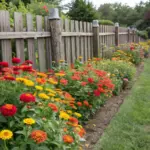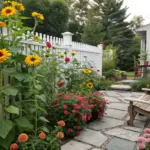9. Edible Garden Border: Combining Beauty with Functionality

Creating the Perfect Border Layout
Let me tell you about my first attempt at combining zinnias with my vegetable garden – it was quite the learning experience! I initially just scattered seeds randomly along the edge, but boy, was that a rookie mistake. Now I know that thoughtful planning makes all the difference when creating an edible border. Start by mapping out your border width – I’ve found that a 2-3 foot wide strip works perfectly for most gardens. The key is to plant your tallest zinnias (like the Giant Dahlia variety) towards the back of the border, gradually stepping down to shorter varieties in front.
Companion Planting Magic
Here’s something cool I discovered through trial and error: zinnias are absolutely fantastic companions for your veggies! They’re not just pretty faces – these flowers actually help your vegetable garden thrive. I love pairing them with herbs like basil, oregano, and thyme. These combinations not only look stunning but also help deter pests naturally. My favorite edible flowers to mix in include nasturtiums and calendula, which add splashes of orange and yellow while being totally edible themselves!
Smart Path Planning
Let’s talk about one of my biggest garden design breakthroughs – functional pathways. After struggling to harvest without trampling my plants (we’ve all been there!), I started incorporating 18-inch wide stepping stone paths every 4 feet through the border. This simple addition has made maintaining and harvesting from both the zinnia border and vegetable beds so much easier. I use flat natural stones that complement the garden’s aesthetic while providing stable footing.
Adding Vertical Interest
Want to know what really transformed my edible border? Vertical elements! I installed some copper pipe trellises (sounds fancy, but they’re actually pretty affordable to DIY) and trained climbing plants like scarlet runner beans up them. The vertical dimension adds such amazing visual interest while maximizing growing space. Plus, it creates these gorgeous “living walls” that make the whole garden feel more intimate and organized.
Remember to deadhead your zinnias regularly – this keeps them blooming continuously and provides you with fresh cut flowers for your kitchen table. I make it a habit to check my border every other morning while I’m harvesting vegetables. It’s become one of my favorite garden meditation moments.
Ready to discover another exciting way to transform your yard with zinnias? Click the next button below to explore our final idea – the enchanting “Mini Meadow Garden.” Trust me, if you love natural-looking gardens that practically take care of themselves, you won’t want to miss this one!










GIPHY App Key not set. Please check settings